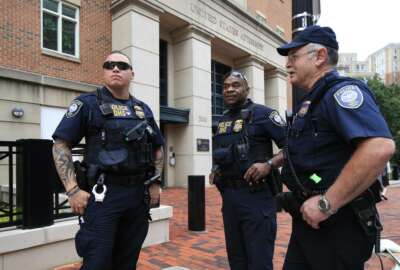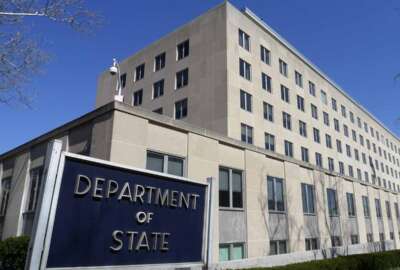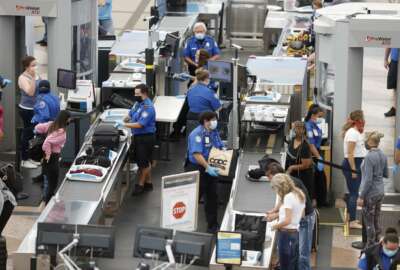Federal security agency struggling with new IT system for tracking contract guards
The IT challenges come as multiple agencies have been forced to close their offices for hours or even a full day due to a shortage of federal security guards.
The Federal Protective Service’s new IT system for managing thousands of federal security guards doesn’t work properly after more than five years of development.
The “Post Tracking System,” or PTS, has been in the works since 2018. FPS is now trying to deploy the system across all its guard contracts through the end of this year.
FPS contracts with private security companies to guard most posts at more than 8,500 federal facilities across the country. The PTS system is intended to help the agency track and manage approximately 14,000 contract security guards, who are also known as Protective Security Officers or PSO’s.
But David Marroni, director of the physical infrastructure team at the Government Accountability Office, said PTS functionality is limited.
“The nationwide deployment of PTS is ongoing; however, the system is not fully functional in any region because of technology, data reliability, and interoperability issues identified by FPS and security guard contractor officials,” Marroni testified during a July 23 hearing held by the House Transportation and Infrastructure Committee’s economic development, public buildings, and emergency management subcommittee.
FPS has spent nearly $30 million on development of PTS. But FPS Director Kris Cline told the subcommittee that the agency “allowed it to grow incrementally more than we needed to.”
“We need to get back to the basis of the intention of the post tracking system,” Cline said. He added that FPS officials want to make sure the system includes key information on the PSO’s, including sign-in data, security clearances, and training information.
Marroni’s testimony describes how in some cases where PTS has been deployed, contract guards are still using paper-based processes due to the system’s functionality issues. GAO found that PTS isn’t fully interoperable with other FPS systems that store information on guard training and other key data, forcing users to manually upload data from those systems.
Users also told GAO that the system sometimes crashes when more than one guard tries to sign in at the same time. And they told the auditor that PTS isn’t fully interoperable with vendor-supplied equipment. PTS also frequently faces internet-connection issues.
Marroni said GAO will have more details on challenges with PTS in a forthcoming report.
Meanwhile, Cline said he has assigned a senior advisor to oversee the PTS program. He said FPS is planning to establish a “tiger team” to address challenges with the system as soon as GAO finishes its report.
“We’ve already started to get this corrected, putting the right people in the right box to fix this,” Cline said. “It’s not a hard thing to fix.”
Federal security guard shortages
The challenges with PTS come as the FPS also confronts a shortage of PSO’s to stand post at federal facilities.
“FPS officials said that open posts are due to security guard contractors hiring insufficient personnel to meet contract guard requirements to meet regional needs,” Marroni’s testimony states. “However, security guard contractors said they face challenges in recruiting, training, and retaining contract guards. According to FPS officials, they prioritize open posts and address this issue with security guard contractors through corrective action plans.”
Federal security guard shortages have forced some agencies to close field offices for hours or even full days in recent years.
The Social Security Administration, for instance, told GAO that FPS hasn’t been able to provide enough contract guards to cover SSA offices for the last three fiscal years. As a result, SSA has closed 510 offices for several hours or a full day, which “negatively affected the agency’s ability to serve the public, specifically vulnerable populations that needed assistance,” GAO reported.
IRS officials also told GAO that “they do not receive timely communication about how guard shortages affect their facilities, often learning weeks later that posts were not staffed from local IRS agency officials.”
Since fiscal 2022, IRS has had to close 30 Taxpayer Assistance Centers for a full day due to guard shortages.
“IRS officials said that real-time information on post staffing and better communication would have allowed them to take proactive steps to limit such problems,” Marroni reported in his testimony.
During the House subcommittee hearing, Chairman Scott Perry (R-Pa.) questioned whether the delayed PTS system would have allowed the FPS to provide more real-time information to agencies about guard shortages.
“In theory, PTS … was supposed to provide the capability remotely for FPS to see if these posts are being staffed,” Marroni said during the hearing. “And that would be an important capability, because then you could say, ‘Okay, this post, isn’t there. Let’s reach out to the vendor. Let’s tell IRS and SSA. Let’s figure out, are there mitigations that we can do?’”
Cline said the PTS is supposed to notify FPS when a guard is not on post, but “we’re not there yet.” Instead, he said agency office managers will typically contact FPS when a PSO doesn’t show up.
“We immediately coordinate with the vendor – what’s going on? Where’s your backup, where’s your other person?’” Cline said. “At the same time, now we are dispatching our law enforcement officers to respond to that location.”
Guard tests and officer retention
As part of its audit, GAO also conducted 27 “covert” tests at federal security posts. In 13 of those tests, auditors were able to successfully smuggle a prohibited item, such as a knife, baton or pepper spray, into the facility.
Cline said PSO’s go through 16 hours of x-ray screening training and eight hours of training on the metal detector. He added that FPS’s professional development directorate is now working on ways to improve that training. Since many FPS systems are similar to those used by the Transportation Security Administration, Cline said his agency is looking to potentially collaborate with the TSA Academy on training.
“We know we need to increase our ability to detect prohibited items,” Cline said. “A big priority for us right now is to get this fixed.”
Meanwhile, FPS is also working to fill vacancies in its cadre of federal law enforcement officers. Cline said FPS currently employs 1,140 law enforcement officers. He said the agency is short 409 officers, down from approximately 500 vacancies a year-and-a-half ago.
By the end of August, Cline said FPS will have an additional 67 employees onboard. He said the agency also made 45 job offers at last month’s Department of Homeland Security job expo in Dulles, Va.
FPS recently introduced a retention incentive for uniformed officers at the GS-12 pay scale and below.
“We’ve got an election coming up,” Cline said. “We’ve got a certification, we’ve got an inauguration. I need to keep as many people as I can onboard until I can fill those current vacancies. And then we can get rid of the retention incentive.”
Copyright © 2025 Federal News Network. All rights reserved. This website is not intended for users located within the European Economic Area.
Follow @jdoubledayWFED






